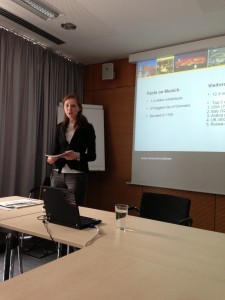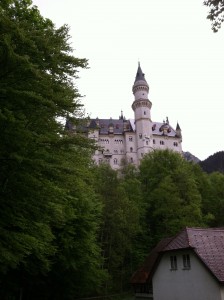by Katie Pflug
Isabella Schopp, who works in public relations for the Munich Tourism Office, really knows her facts about the third biggest city in Germany and was not shy to share them with Point Park University’s International Media class.
Munich, known as the “all around city,” is home to 1.4 million people. That number seems like nothing compared to the 12.4 million visitors Munich achieved in 2012, which was a record year. The United States of America, Italy, Arabia, The United Kingdom and Russia are among the countries with the leading amount of tourists that visit each year, Schopp said.
It also has the second largest number of universities, right after Berlin. Munich has 104,000 students in 15 universities, Schopp said.
Founded in 1158, Munich is now the center of science and economy. High tech industries like BMW, EADS, and The Linde Groupe all call Munich home. Google, Siemens and Microsoft are also some of the leading I&C companies in Munich. Munich is now the second largest city for broadcasting companies, right after New York City.
But, Munich has much more to offer than just being a great business hub. Munich is full of culture, castles, history, churches, shopping, beer gardens, all set in an amazing location.
There are 63 museums in Munich, along with 100 theaters, two operas and three orchestras. The Nymphenburgh Palace and Royal Residence are some of the castles in the area that are a must see while visiting Munich. Right outside of Munich there are also the castles Neuschwantstein and Linderhof. Castles are large part of Bavarian culture and a beautiful way to explore the history of the area.
Munich is a very green city with many parks. As well as the many parks throughout Munich, 80 percent of locals own a bike, Schopp said. The beer gardens also make many people want to be outside, she said. In this particular part of Germany, visitors are able to bring their own food to the beer gardens. That is something that is not permitted in the northern part of Germany. Beer gardens have been around 200 years and are some of the main attractions for visitors.
Munich is a very busy city for events. During February there was the Munich Creative Business Week. In May there was the Long Night of Music. Coming in June there will be the City Foundation Festival, celebrating 855 years of Munich. Later in June, Munich will be hosting the Summer X-Games, Schopp said. Of course in late September into early October there will be Oktoberfest, which marked its 200th anniversary in 2010. Then in the end of November all the way until Christmas Eve, the Christmas Market will be available to residents and tourists.
The Munich Tourism Board’s general manager is Geraldine Knudson. There are five different departments of the Munich Tourism Office: Marketing, Convention Bureau, Tourist Information, International Media and Public Relations.
The International Media is the branch of the office that Schopp is involved with, having previously served as a tour guide. She and her colleagues are responsible for the press kits, online image database, footage, the international newsletter, press trip assistance, film and photo permits, interviews. and research assistance.
Working in the International Travel Media section of the Munich Tourism Office are five colleagues and a trainee.
The Munich Tourism Office has professional photographers on staff, but sometimes it will buy photos from other journalists, Schopp said. The in-house photographers are responsible for the photo archives.
The Munich Tourism Office plays a big role in educating journalists and others about what Munich has to offer, she explained. And although Schopp will visit London and Paris to meet some of them and pitch Munich travel stories, “The journalists come to us for stories, not vice versa.” It also plays a huge role in organizing events such as Oktoberfest and the Christmas Market in Marienplatz.
The Munich Tourism Office works with the Germany National Tourist Board, which she said is its most important partner, the Bavaria Tourism Marketing GmbH, Magic Cities Germany and the Munich Airport to do its support work.
Journalists from Toronto Star, Budget Star, and Irish Times have all used the Munich Tourism Office for their resources. When the journalists check into the hotels they have a press kit waiting for them, Schopp said, and the Point Park students each received a scaled-down one as a sample. The press kit includes Munich Facts and Figures, a city map, a Munich City Guide, Munich Events, and Photo Services papers.
The press kits the Point Park group also had paperwork giving students and faculty permission to write, photograph and film within the city, something that is standard procedure for the Tourism Board to do for groups.
There are many different types of journalists that would find writing about Munich exciting as well as on-topic with their publication. Munich’s target market is really anyone because of the vast amount of things to do and a lot of families find that Munich is the perfect place to go because of that.
Visitors looking to stay in Munich will find no shortage of hotel rooms. There are around 300,000 hotel rooms in the city of Munich itself.
Schopp has been working at the Munich Tourism Office for three years and said she loves being in direct contact with the journalists.
More information is available on the city at the Munich Tourism Office’s website at www.meuchen.de or via email at travel.media@muenchen.de.


